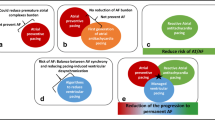Abstract
The PIPAF trials are a set of randomized multicenter studies which seeks to evaluate the potential preventive effect of different modes of pacing in patients with drug refractory paroxysmal atrial fibrillation by means of a permanent pacemaker. The objective of the studies are (1) to significantly prolong the time to first recurrence of atrial arrhythmia and (2) to significantly reduce the cumulative arrhythmia duration. The role of the atrial pacing site (left or right), the overdriving of the sinus rate, and the suppression of the post extrasystolic compensatory pause are evaluated alone or in association, giving rise to four distinct pacing protocols. Over a period of 2 years, 220 patients will be included in 35 centers from 5 different countries.
Similar content being viewed by others
References
Kannel WB, Abbott RD, Savage DD, et al. Epidemiologic features of atrial fibrillation. The Framingham Study. N Engl J Med 1982;306:1018–1022.
Gajewski J, Singer R. Mortality in an insured population with atrial fibrillation. JAMA 1981;245:1540–1544.
Barnay C, Coste A, Quittet F, et al. Stimulation auriculaire permanente exclusive: Expérience clinique à propos de 65 observations avec un recul de 1 à 5 ans. Arch Mal Coeur 1986;79:1703–1710.
Rosenqvist M, Brandt J, Schuller H. Long-term pacing in sinus node disease: Effects of stimulationmode on cardiovascular morbidity and mortality. Am Heart J 1988;116:16–22.
Sutton R, Kenny RA. The natural history of sick sinus syndrome. PACE 1986;9:1110–1114.
Santini M, Alexidou G, Ansalone G, et al. Relation of prognosis in sick sinus syndrome to age, conduction defects, and modes of permanent pacing. Am J Cardiol 1990;65:729–735.
Andersen HR, Thuesen L, Bagger JP, et al. Prospective randomized trial of atrial versus ventricular pacing in sick sinus syndrome. Lancet 1994;344:1523–1528.
Coumel P, Attuel P, Lavallee JP, et al. Syndrome d'arythmie auriculaire d'origine vagale. Arch Mal Coeur 1978;71:645–656.
Coumel P. Long term prevention of vagal arrhythmias by atrial pacing at 90/mn. Experience with 6 cases. PACE 1983;6:552–560.
Han J, Millet D, Chizzinotti B, et al. Temporal dispersion of atrial refractoriness as a function of heart rate. Am Heart J 1966;71:481–487.
Han J, Detraglia J, Millet D, et al. Incidence of ectopic beats as a function of basic heart rate in the ventricle. Am Heart J 1966;72:632–639.
Goel BG, Han J. Atrial ectopic activity associated with sinus bradycardia. Circulation 1970;42:853–858.
Bayes de Luna A, Cladellas M, Oter P, et al. Interatrial conduction block and retrograde activation of the left atrium and paroxysmal supraventricular tachyarrhythmia. Eur Heart J 1988;9:1112–1118.
Daubert JC, Mabo P, Berder V, et al. Atrial tachyarrhythmias associated with high degree interatrial conduction block: Prevention by permanent atrial resynchronisation. Eur J C P E 1994;1:35–44.
Daubert JC, Pavin D, Victor F, et al. Cardiac pacing for terminating and preventing atrial flutter and fibrillation. In: Saoudi N, Schoels W, El-Sherif N, eds. Atrial Flutter and Fibrillation: From Basic to Clinical Applications. Armonk, NY: Futura Publishing Company, Inc, 1998:293–315.
Saksena S, Prakash A, Hill M, et al. Prevention of recurrent atrial fibrillation with chronic dual-site right atrial pacing. J Am Coll Cardiol 1996;28:687–694.
Josephson ME. Atrial flutter and fibrillation. In: Josephson ME, ed. Clinical Cardiac Electrophysiology: Technique and Interpretations. Philadelphia: Lea & Febiger, 1993: 275–310.
Papageorgiou P, Monahan K, Boyle NG, et al. Site-dependent intra-atrial conduction delay: Relationship to initiation of atrial fibrillation. Circulation 1996;94:384–389.
Papageorgiou P, Anselme F, Kirchhof CJHJ, et al. Coronary sinus pacing prevents induction of atrial fibrillation. Circulation 1997;96:1893–1898.
Prakash A, Saksena S, Hill M, et al. Acute effects of dual-site right atrial pacing in patients with spontaneous and inducible atrial flutter and fibrillation. J Am Coll Cardiol 1997;29:1007–1014.
Prakash A, Delfaut P, Krol RB, et al. Regional right and left atrial activation patterns during single-and dual-site atrial pacing in patients with atrial fibrillation. Am J Cardiol 1998;82:1197–1204.
Wood MA, Mangano RA, Schieken RM, et al. Modulation of atrial repolarization by site of pacing in the isolated rabbit heart. Circulation 1996;94:1465–1470.
Fisher JD. Antitachycardia pacing in the acute care setting. In: Saksena S, Goldschlager N, eds: Electrical Therapy for Cardiac Arrhythmia.
Murgatroyd F, Nitzsché R, Slade AKB, et al. A new pacing algorithm for overdrive suppression of atrial fibrillation. PACE 1994;17:1966–1973.
Fitts SM, Hill MRS, Mehra R, et al. Design and implementation of dual site atrial pacing to prevent atrial fibrillation (DAPPAF) clinical trial. J Interv Cardiac Electrophysiol 1998;2:139–144.
Wharton JM, Sorrentino RA, Campbell P et al. Effect of pacing modality on atrial tachyarrhythmia recurrence in the tachy-bradycardia syndrome: Preliminary results of the pacemaker atrial tachycardia trial. Circulation 1998;98(Suppl I):2601 (Abstract).
Hill MRS, Dinsmoor DA, Kleckner KJ, et al. Impact of atrial pacing on atrial fibrillation onsets in the PA3 trial. Circulation 1998;98(Suppl I):3740 (Abstract).
Limousin M, Geroux L, Nitzsché R, et al. Value of automatic processing and reliability of stored data in an implanted pacemaker. PACE 1997;20:2893–2898.
Author information
Authors and Affiliations
Rights and permissions
About this article
Cite this article
Anselme, F., Saoudi, N. & Cribier, A. Pacing in Prevention of Atrial Fibrillation: The PIPAF Studies. J Interv Card Electrophysiol 4 (Suppl 1), 177–184 (2000). https://doi.org/10.1023/A:1009867623573
Issue Date:
DOI: https://doi.org/10.1023/A:1009867623573




